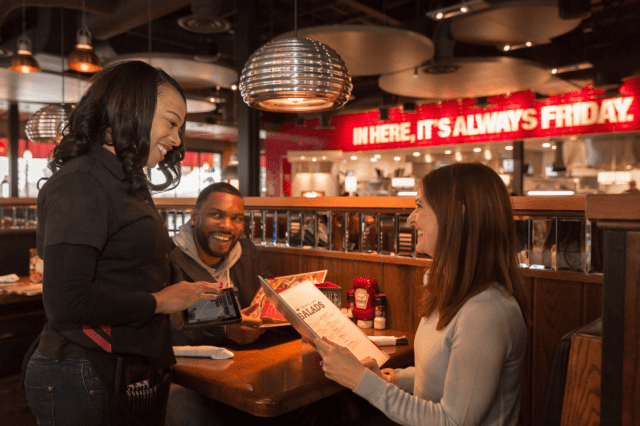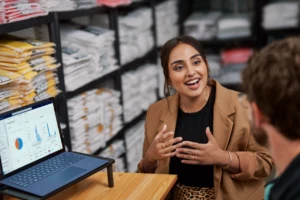2015: The year of on-demand, personalized shopping

At Microsoft, we believe this will be the year when modern shopping experiences come to life. Where retailers create instant, personalized experiences for shoppers on their smartphone, online and in stores. It will be the year that customers return to stores because technology is engaging them in new ways, making them want to buy more and come back. At the National Retail Federation Annual Convention today in New York City, Microsoft made announcements with GameStop, Hardee’s, TGI Fridays, Panasonic, HP, FreedomPay, and NCR on efforts to modernize shopping experiences. Microsoft also shared for the first time several retail innovations using its technology, including a smart shelf and a tablet-enabled shopping cart, and showed how retailers can gather better store analytics. Finally, Microsoft announced how Pandora and Ashley Furniture are working with technology to create more engaging experiences for employees, helping them be more collaborative and support faster product innovation.
Engaging customers during the shopping experience is essential for today’s retailers. Today, GameStop announced it is working with Microsoft to create an interactive, informative and entertaining shopping experience in an immersive environment. In the near future, when customers walk into one of the GameStop pilot stores, they will be connected to the services enabled by the Microsoft Cloud, allowing them to browse product choices, share their shopping cart with salesperson’s tablet running an assisted selling application, and even browse products interactively on a big screen Ultra High Definition TV where they can view video game trailers with pristine clarity. When a customer downloads and opts into the GameStop app on their smartphone, they will be able to interact in a whole new way with GameStop marketplace through the use of Azure. Ultimately, the customer and the salesperson can push the desired products to the point of sale (POS) system for order processing and payment.
Another great example of how Microsoft is working with retailers to improve customer engagement is Hardee’s new way to make ordering a meal fast and fun. Hardee’s is currently deploying self-ordering kiosks for ordering meals, using Windows 8 devices. These in-store kiosks are being tested currently in 30 restaurants with plans to extend that test to additional restaurants soon. Each kiosk allows customers to review the menu and order food and lets managers run sales and shift reports, while dramatically reducing wait times. Check out the video, and read more here.
TGI Fridays plans to transform the way people order food by equipping servers with 8-inch tablets armed with payment sleeves. With the Fridays’ Service Style technology the customer’s order is processed right at the table, the device also helps manage the waiting list and queue. The solution helps ensure orders are correct, reduces training time, and streamlines waitlists.
Modern points of sale connect retailers and customers in new ways
As the shopping experience becomes more modern, so does the POS. Modern POS devices are allowing retailers to better understand their customers, provide more customized service, and help them achieve compliance with new security measures being implemented in 2015. In partnership with Panasonic, HP and FreedomPay Microsoft is demonstrating how the modern POS can create personalized retail experiences, in real-time, through smart and secure devices. With new security regulations on the horizon, retailers need to upgrade their POS devices, not only to ensure their customer data is safe, but to also be able to provide a more personalized and seamless experience at check-out. Read more about modern POS devices here.
Innovation that helps retailers understand buying behavior and customers make informed decisions
One of the challenges in retail is to create an in-store experience that engages customers in unique ways, entices them to come in to stores, and keep them coming back. Creating those connections creates better experiences and ultimately increases sales. With the help of a Kinect sensor, AVAretail’s SmartShelf technology allows every interaction of a shelf in a store to be monitored and recorded in real-time, providing insight into which products are most selected and picked up by customers. Another form of technology, Path Tracker, gives retailers real-time detection and analysis of a customer’s shopping path. This provides counts of people in the store, areas visited, dwell time and shopping path, acting as a heat map of where customers are spending the most time in the store.
The NEC Biometric interface with Kinect Camera system provides demographic and face recognition services to a Kinect enabled application. Retailers can use this information for analysis and for providing the customer with a more personal selling experience. MediaCart will change the shopping cart as we know it. Adding a location-aware tablet to the cart allows a retailer to present a personal and relevant shopping experience to its customer. This allows context sensitive ads and promotions when in front of various products along with a barcode scanning capability for price lookups and basket totals.
Retailers predicting consumer behavior with machine learning
As technology advances, consumers have more tools at their disposal during the buying process. This trend seems to be growing exponentially, especially as the Internet of Things (IoT) matures. This is both an opportunity and a challenge for retailers looking to capitalize on a whole new base of consumers. Competitive pressure, combined with ubiquitous connectivity, smart devices and an intelligent cloud platform is causing a shift to a new retail reality. Food delivery company JJ Food Service uses machine learning to make product recommendations as customers are shopping for food. This provides insights, saves on costs, and ensures their customers have the food they need, when they need it.
Auckland, New Zealand-based VMob runs a mobile engagement platform on Microsoft Azure which predicts likely customer behavior based on historic and live data streams. The platform currently delivers personalized content to millions of consumers around the world, including customers of McDonald’s across several European markets. The VMob platform collects real time data from multiple sources including mobile devices, wearables, location temperature sensors, WiFi transmitters, beacons, digital signage, and POS systems to personalize engagement with the customer. The VMob platform uses Azure Machine Learning to harness the Internet of Things to predict future customer behavior – transforming live and historical data streams into actionable insights McDonald’s can employ to individualize its marketing efforts. See more information about VMob’s work here.
Reaching your customers where they are
For retailers to succeed, they need to reach their customers where they are. Because of this, we are pleased to be announcing Sitecore Commerce, powered by Microsoft Dynamics. This solution integrates the experience management capabilities of the Sitecore Experience Platform with the omni-channel commerce capabilities of Microsoft Dynamics AX for Retail. The result is a product that allows enterprises to bridge the gap between in-store and digital experiences. We are also announcing a combined effort with Toshiba to form the Toshiba Global Commerce Solutions with Microsoft Dynamics to help retailers deliver leading customer experiences through true omni-channel customer engagements. This effort includes Toshiba delivering software and implementation services on the Dynamics platform as well as plans for the global availability of a combined solution – TCxGravity powered by Microsoft Dynamics – specifically tailored to deliver omni-channel transformation on the customer’s terms, helping it provide seamless brand experiences to build lasting loyalty.
The future of retail
Retailers are changing the game through connected stores, empowered employees, digital engagement and ambient intelligence all geared toward delighting the modern shopper. By gathering and ingesting insight from myriad data sources, retailers can create a comprehensive understanding of each customer, its store’s inventory and the capabilities of its business to seamlessly match people with the products and services they desire.
The end result of these technologies and services, and of Microsoft’s work with retailers, is an increased focus on solutions that help grow sales and profits, increase customer satisfaction and loyalty, bring products to market faster, and create a more effective business.
For more information, visit our Retail Newsroom, The Windows for Your Business Blog, and The Dynamics Blog.




